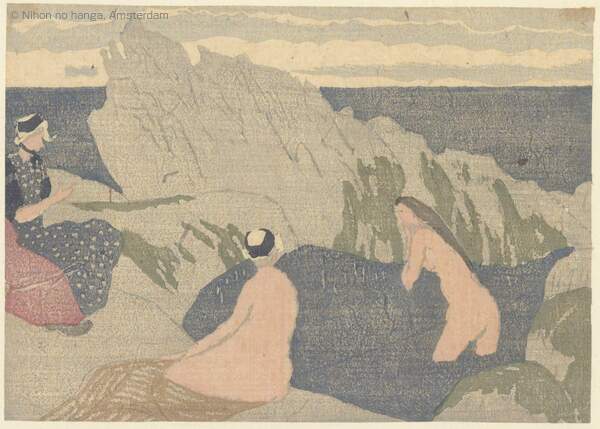5| The Sōsaku hanga movement
-

-
Influenced by Western ideas about the role of the artist in the creative process, a debate emerged in Japan regarding the direction in which woodblock printing should develop. The basic new assumption was that 'art
was self-expression' and, as a consequence, the artists saw the need to take full control over all steps in the production process. In the first decade of the 20th century, artists tested out this new approach, often by creating
illustrations for coterie magazines. This focus on the artist's role marked the beginning of the Sōsaku hanga (Creative prints) movement.
Artist Yamamoto Kanae is credited with making the first Sōsaku hanga print, titled Fisherman (Gyofu), as an illustration for the magazine Myōjō in 1904. Such coterie magazines played an important role in the movement and created a forum for intellectuals and an artistic avant garde, whereby artists involved themselves in art theory, politics, and literary issues. The movement developed much in the same way as, for instance, Vienna's Secession movement was developing at that time.
In subsequent decades, an enormous surge of creative activity followed. Magazines came and went, and artist associations were formed and dissolved again, in a more or less continuous battle against the established governmentsponsored art schools and exhibitions such as the Bunten and Teiten.
One of the most influential groups to form at this time comprised three artists: Onchi Koshirō (1891-1955) who led the group, as well as Tanaka Kyōkichi (1892-1915) and Fujimori Shizuo (1891-1943). In 1913, they created a journal focused on printmaking and poetry, titled Tsukuhae (Reflection of the Moon). Its style reflected strong Western influences and the prolific Onchi supplied many illustrations. The group created a new paradigm for art magazines in that, through publication, they sought to express complete artistic freedom. Tsukuhae folded due to financial difficulties within two years, after just seven issues were produced.
In 1918 the Japan Creative Print Association was formed by Yamamoto Kanae, Oda Kazuma (1881-1956), Terasaki Takeo (1883-1967), and Tobari Kogan (1882-1927). They staged department store exhibitions attracting large crowds; following this success, the Sösaku hanga movement gained momentum. Onchi was the leading artist, but much young talent revealed itself, most notably Hiratsuka Un'ichi (1895-1997), Maekawa Senpan (1888-1960), Koizumi Kishio (1893-1945) and Kawanishi Hide (1894-1965).Apart from the subject of choice, the female form, new subject matter was found in the restyling of Tokyo following the devastating Kanto earthquake of 1923. Not only the urban landscape and its architecture, but also Western urban activities such as baseball and the circus, became typical subjects of their prints. Whereas, early on, magazines formed their main medium, in the 1920s and 30s publication often took place in the form of portfolios. Sometimes sets were produced in large series such as Koizumi Kishio's One hundred views of great Tokyo in the Showa period, following the traditional Ukiyo-e example.
Broad Strokes and Fine Lines
The distinction between Shin hanga and Sösaku hanga is not always clear. Though Sōsaku hanga artists put more emphasis on their individual roles, they often had either block carvers or printers working for them, and occasionally, Shin hanga artists would immerse themselves in the production process. The stylistic distinction, however, is almost always visible: fine lines, precise registration and ample use of gradation printing and overprinting belong to the domain of Shin hanga, while broad strokes, crude, smudgy lines, and the application of primary colors are the traits of the Sösaku hanga style.
-
Related Entries
